Article submitted by Chris Jones
My great grandfather had told his grandchildren why he objected to going to the war but is only these records found two years ago that partially confirmed his story……..
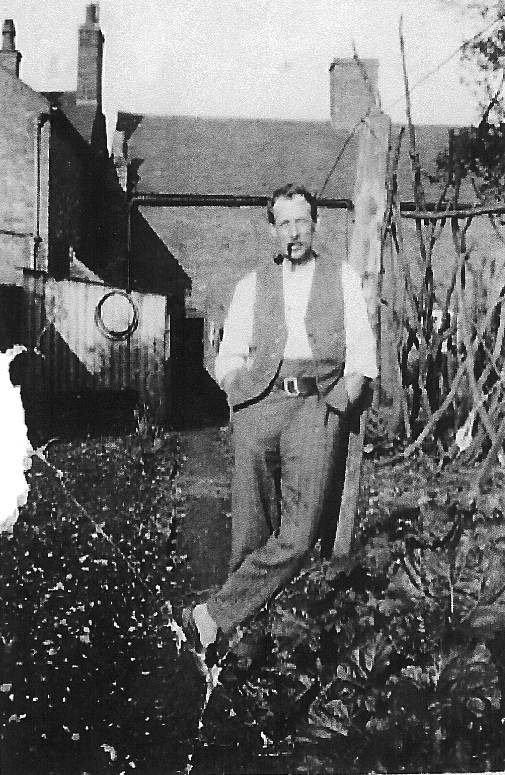
I was fortunate to find details of my great grandfather (Arthur William Phipps) in the tribunal appeals held at Staffordshire Archives. Our family knew about the story, but the records we were fortunate to find now prove it.
About Arthur – his birth, early life and marriage
Arthur was born in 1883 at Hopwas, the youngest son of George and Ellen Phipps. His father was a gardener on the Peel estates (now Drayton Manor Park and Zoo).
Arthur grew up in the village and attended the village school before going to work with his older brothers at the local paper mill – Alders. In 1906 he met and married Ethel Ball who came from a pottery family and lived in the village. They moved into a small terraced house in Hints Lane – which he lived for the rest of his life – and they had three children (Ethel, Mabel and George) between 1907 and 1910. Sadly within a week of giving birth to George, Ethel passed away from blood poisoning.
Arthur took a housekeeper to help with the children and moved work to be with his father on the Peel estates between Fazeley and Hopwas working in the gardens and in woodlands.
The war years
At the outbreak of war Arthur carried on working and sadly his youngest sister – Jessie – lost her husband – H Cornwell in November 14 on the western front leaving her with 4 young children.
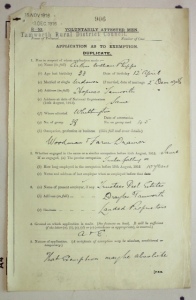

The documents show that in 1916 Arthur was assessed and called to join the army but requested exemption due to the nature of his work and being the last fit man on the forestry part of the team.
According to Arthur he also objected to going as at that time he was responsible for his two girls – his son by now being brought up by a sister in Birmingham.


Arthur succeed in gaining an exemption twice according to the documents and local newspaper reports we have seen but eventually his exemption was dismissed. He stated later that he agreed to join up on condition he was not put in the front line as he argued the state would have to pay to bring up his children if he did not return.

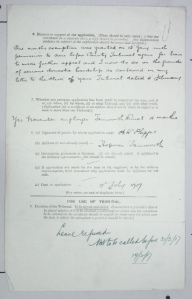
It was agreed for him to join the Army Service Corps and we believe he worked in what would now be called logistics in Palestine and then moving to Salonika in Greece towards the end of the war. He told family that he didn’t enjoy his war experience and was somewhat resentful that he had been called up. At one point we know he got in a lot of trouble trying to catch local Palestinians who were stealing the food from the stores using rather zealous methods!
In 1918 Arthur’s nephew was killed in France serving with a Yorkshire regiment after transferring from the North Staffords along with two other men he knew pre-war from local farming families.
Post war
On demob he returned to Hopwas and worked on the Peel estates well into the 1930s, getting to know the family well. After they sold the estate Arthur moved to work on local farms and became a well-known local character frequenting the local Chequers Public House every night – even being given a certificate by the brewery – after he had been drinking there since his childhood! His nickname was ‘Chick’ though we don’t know why!

In later years one of his sisters moved in with him and he eventually passed away in 1971. His ashes are in his sister’s grave at Hopwas – his wife being buried in the churchyard beside his parents near to many other members of his family.
His nephew and brother-in-law are listed on the war memorial alongside one of the Peel sons who Arthur would have known pre-war.
The photos of Arthur show him in his garden in Hints Lane – post war – about 1930 and later in life on the day of being given the award by Courage Brewery.
Images of the following Military Appeal Tribunal Records, illustrated in the above article, are held at Staffordshire Record Office, and published courtesy of Staffordshire Archives and Heritage:
C/C/M/2/14b/1095 – papers relating to Arthur Phipps
C/C/M/21/16b/1295 – papers relating to Arthur Phipps
Note on the Military Appeal Tribunal Records
The following text is an extract from Staffordshire Newsroom. To read more click on the link which follows it:
Stories of conscientious objectors and how bakers, butchers and farmworkers fought conscription are amongst a rare collection of Military Appeal Tribunal records being published for the first time.
Conscription was first used by the armed forces in 1916 and those who sought exemption were brought in front of Military tribunals to make their case. After the war, the Ministry of Health ordered that all tribunal records be destroyed, but an oversight meant Staffordshire’s collection survived.
Now, exactly one hundred years later, Staffordshire & Stoke-on-Trent Archive and Heritage Service have published this rare collection, making them available online.
It’s believed the tribunals were held in County Buildings in Stafford and the records were hidden away there only to be discovered many decades later.
Over 20,000 individual cases for the Local and Appeal Tribunals reveal the lives of the men called up to service and the stresses and strain it had on work and family life. Reasons provided by applicants are varied, including moral grounds, medical, family and on economic grounds.
People can search the records online at http://www.staffsnameindexes.org.uk/ and request copies of the documents.
http://www.staffordshirenewsroom.co.uk/rare-archives-shed-light-conscription-wwi/

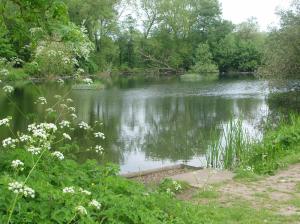 After these talks there was then a chance to join in on two workshops. Firstly I joined a workshop where we talked about funding opportunities. It was hosted by two ladies from
After these talks there was then a chance to join in on two workshops. Firstly I joined a workshop where we talked about funding opportunities. It was hosted by two ladies from  website
website  On the website you use the drop down tag : Discover : then History and then finally Historypin (located at the very bottom of the page). Anyone can add material but we were warned to be careful of copyrights on pictures but your own are ok to include. They are looking for any information that people may have whether it is concerning mining, the wars, people history ( who was where and where did people go) , the waterways or just memories.
On the website you use the drop down tag : Discover : then History and then finally Historypin (located at the very bottom of the page). Anyone can add material but we were warned to be careful of copyrights on pictures but your own are ok to include. They are looking for any information that people may have whether it is concerning mining, the wars, people history ( who was where and where did people go) , the waterways or just memories.
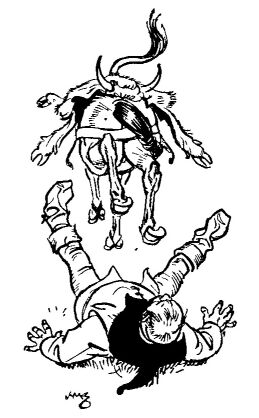 that cowhides are in great demand. Edward then asks to switch horses with the tanner. The tanner replies that he’ll do the trade but only for a gold noble (80d). Edward, amused, gives him twenty groats (80d), which raises the tanner’s opinion of him a bit. The tanner hands over his mare, throws the cowhide over the king’s gilt saddle, and tries to ride home; but the cowhide spooks the king’s steed and it throws the tanner onto the ground.
that cowhides are in great demand. Edward then asks to switch horses with the tanner. The tanner replies that he’ll do the trade but only for a gold noble (80d). Edward, amused, gives him twenty groats (80d), which raises the tanner’s opinion of him a bit. The tanner hands over his mare, throws the cowhide over the king’s gilt saddle, and tries to ride home; but the cowhide spooks the king’s steed and it throws the tanner onto the ground. “Thomas Guy” makes an appearance at his
“Thomas Guy” makes an appearance at his Almshouses, posing proudly below his coat of arms (photo by D. Biggs). TDCS would like to see a statue of our town’s great benefactor Mr. Guy erected in the town. On the right: Blooming marvellous! The Castle Grounds show why Tamworth has won Gold in the Small Cities category of the Heart of England in Bloom competition for ten consecutive years. Well done to all concerned.
Almshouses, posing proudly below his coat of arms (photo by D. Biggs). TDCS would like to see a statue of our town’s great benefactor Mr. Guy erected in the town. On the right: Blooming marvellous! The Castle Grounds show why Tamworth has won Gold in the Small Cities category of the Heart of England in Bloom competition for ten consecutive years. Well done to all concerned. The “Mediaeval Grave-diggers” literally worship The Worshipful The Mayor of Tamworth, and the Mayoress. His Worship looks bemused!
The “Mediaeval Grave-diggers” literally worship The Worshipful The Mayor of Tamworth, and the Mayoress. His Worship looks bemused!










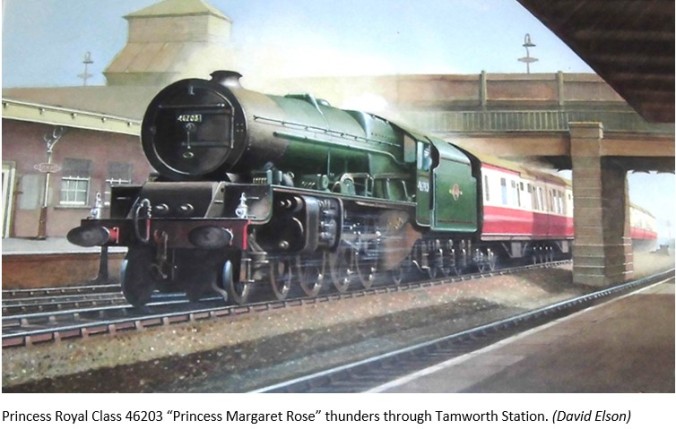
 On the low level, there were two “up” lines to London and two “down” lines to the North West and Scotland. The trainspotters developed their own special names and expressions. Sometimes nicknames were used so the signals on the two up lines were nicknamed “Baby (pronounced Babby) Clangers” on the slow line and “Daddy Clangers” on the fast or main one. While there were only two down lines there were, in fact, three signals because of the link from the fast to the slow or local one and these were called “Main” “Main to Local” and “Local”. A signal was “pegged” when it went up and the accompanying shout would indicate which it was. As soon as the engine was in view there was a further shout of “sighted” and then the cry of “Scot” or whatever class of engine it was when it could be identified. Of the two levels the low level was undoubtedly the premier one with its famous expresses like the Royal Scot (London–Glasgow), Irish Mail (London-Holyhead)
On the low level, there were two “up” lines to London and two “down” lines to the North West and Scotland. The trainspotters developed their own special names and expressions. Sometimes nicknames were used so the signals on the two up lines were nicknamed “Baby (pronounced Babby) Clangers” on the slow line and “Daddy Clangers” on the fast or main one. While there were only two down lines there were, in fact, three signals because of the link from the fast to the slow or local one and these were called “Main” “Main to Local” and “Local”. A signal was “pegged” when it went up and the accompanying shout would indicate which it was. As soon as the engine was in view there was a further shout of “sighted” and then the cry of “Scot” or whatever class of engine it was when it could be identified. Of the two levels the low level was undoubtedly the premier one with its famous expresses like the Royal Scot (London–Glasgow), Irish Mail (London-Holyhead) and Mancunian (London-Manchester), drawn by engines from the upper echelons of the locomotive hierarchy, each class of which had its own special name (the Coronations were called “Semis”, the Princess Royals “Prinnies”, the Royal Scots “Scots”, the Jubilees “Jubes” and the Patriots “Pats”).
and Mancunian (London-Manchester), drawn by engines from the upper echelons of the locomotive hierarchy, each class of which had its own special name (the Coronations were called “Semis”, the Princess Royals “Prinnies”, the Royal Scots “Scots”, the Jubilees “Jubes” and the Patriots “Pats”).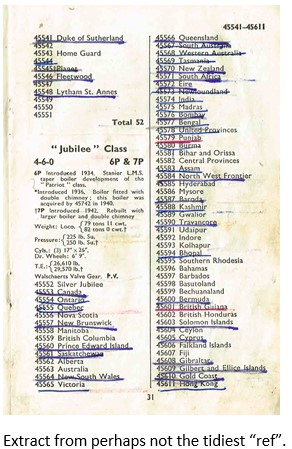
 trainspotters would gravitate there too during quiet periods. As I recall it, its interior was best described as functional with a counter, tables and chairs, table top football, a pinball machine and, of course, the juke box which has been mentioned elsewhere.
trainspotters would gravitate there too during quiet periods. As I recall it, its interior was best described as functional with a counter, tables and chairs, table top football, a pinball machine and, of course, the juke box which has been mentioned elsewhere.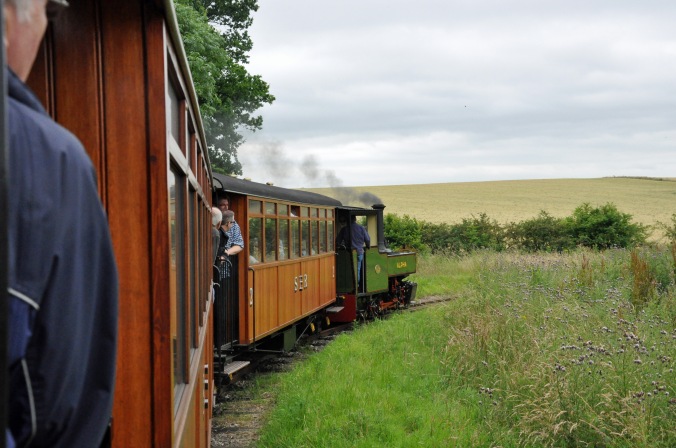
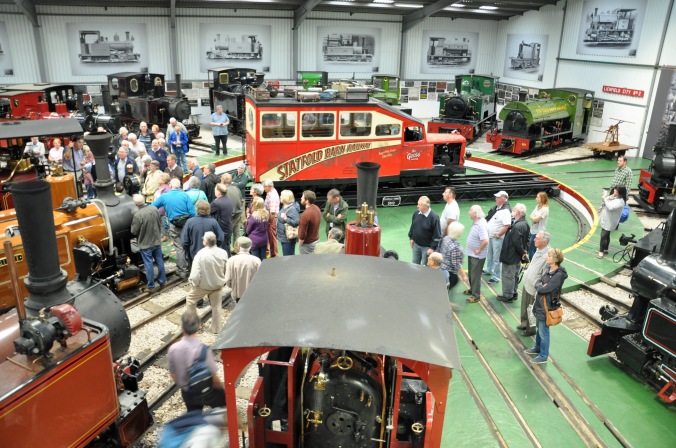
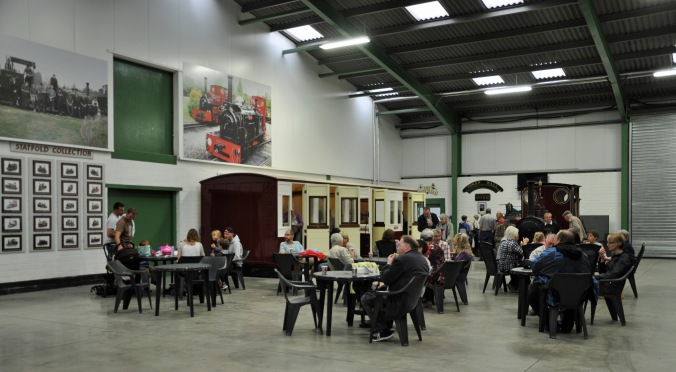
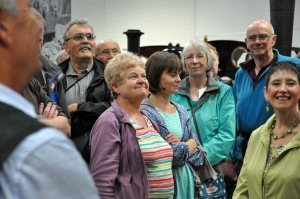


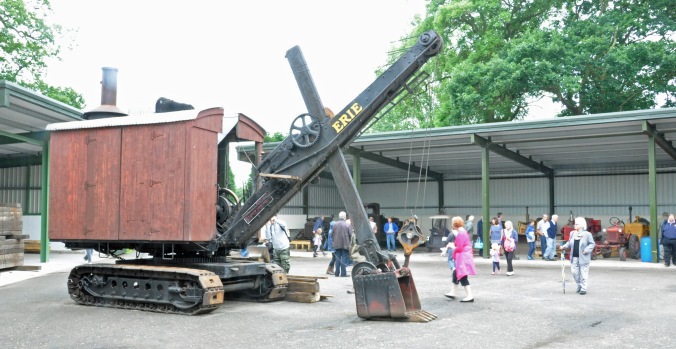

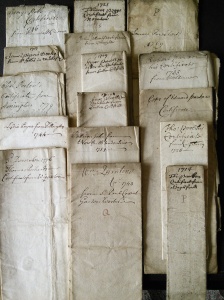 poor relief by the issuing of Settlement Certificates . The certificates state which parish a family belonged to and therefore which parish had the legal responsibility to provide poor relief if needed. These documents were important for a mobile population, who may have needed to travel to procure work or settle elsewhere. They were not issued exclusively to paupers.
poor relief by the issuing of Settlement Certificates . The certificates state which parish a family belonged to and therefore which parish had the legal responsibility to provide poor relief if needed. These documents were important for a mobile population, who may have needed to travel to procure work or settle elsewhere. They were not issued exclusively to paupers.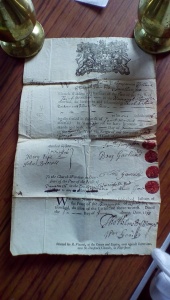 The analysis, which is currently being finalised, will include the dates, names, occupations, the parish where the individual or families originated from, plus the names of witnesses, Churchwardens, Sidesmen and Overseers of the Poor and Justices of the Peace.
The analysis, which is currently being finalised, will include the dates, names, occupations, the parish where the individual or families originated from, plus the names of witnesses, Churchwardens, Sidesmen and Overseers of the Poor and Justices of the Peace.
 This chocolate-box, church, lauded by Pevsner, nestles on Hopwas Hill in the shadow of Hopwas Hayes Wood. It was designed in 1879 by the celebrated architect John Douglas of Chester, and is a Grade II listed building. It is a daughter church of the Parish of Tamworth. The beautiful red brick and half-timbered building, with its distinctive octagonal spire, is a great architectural asset to Tamworth and District.
This chocolate-box, church, lauded by Pevsner, nestles on Hopwas Hill in the shadow of Hopwas Hayes Wood. It was designed in 1879 by the celebrated architect John Douglas of Chester, and is a Grade II listed building. It is a daughter church of the Parish of Tamworth. The beautiful red brick and half-timbered building, with its distinctive octagonal spire, is a great architectural asset to Tamworth and District. both world wars. Exploring the churchyard, one will find various interesting graves, including that of the reforming and philanthropic Vicar of Tamworth, and noted Egyptologist, Reverend William MacGregor, who was one-time Curate at Hopwas and did much to get the new church built, replacing St. John’s in the centre of the village. His plot lies forward of the village war memorial at the east end of the church.
both world wars. Exploring the churchyard, one will find various interesting graves, including that of the reforming and philanthropic Vicar of Tamworth, and noted Egyptologist, Reverend William MacGregor, who was one-time Curate at Hopwas and did much to get the new church built, replacing St. John’s in the centre of the village. His plot lies forward of the village war memorial at the east end of the church. Our correspondent tells us that an excellent new publication, called “Hopwas Papers” was on sale at the fete, and is a ‘must-have’ item for the area’s local historians.
Our correspondent tells us that an excellent new publication, called “Hopwas Papers” was on sale at the fete, and is a ‘must-have’ item for the area’s local historians.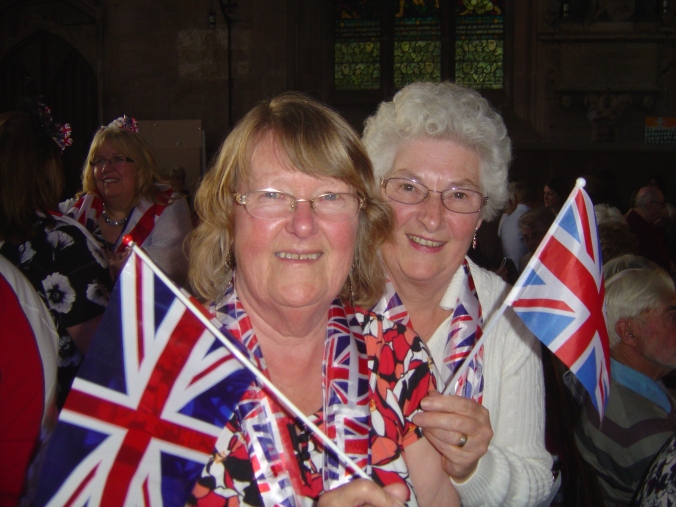
 Church of St Editha to celebrate the Queen’s 90th birthday. The singers and orchestra were excellent, The pews were packed and the church was an ocean of Union and England flags. Everyone seemed to have an enjoyable time.
Church of St Editha to celebrate the Queen’s 90th birthday. The singers and orchestra were excellent, The pews were packed and the church was an ocean of Union and England flags. Everyone seemed to have an enjoyable time. edifice, and for the invaluable work of St. Giles’s Hospice at Whittington which helps so many people in our area.
edifice, and for the invaluable work of St. Giles’s Hospice at Whittington which helps so many people in our area. appreciate and benefit from, whether we are a member of its congregation or not. Its maintenance and restoration is a never-ending labour of love. The Proms concert was a brilliant way to help it, to honour our longest-living and longest-reigning monarch, and to engage with the community. Well done to all involved.
appreciate and benefit from, whether we are a member of its congregation or not. Its maintenance and restoration is a never-ending labour of love. The Proms concert was a brilliant way to help it, to honour our longest-living and longest-reigning monarch, and to engage with the community. Well done to all involved.